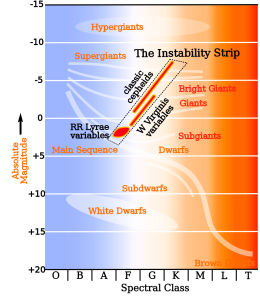Searching for planets around very hot stars is much more challenging than looking around cool stars. For this reason, the recent discovery of a planet around a main-sequence A star is an important find — both because of its unique position near the star’s habitable zone, and because of the way in which the planet was discovered.
Challenges in Variability
In the past three decades, we’ve discovered thousands of exoplanets — yet most of them have been found around cool stars (like M dwarfs) or moderate stars (like G stars like our Sun). Very few of the planets that we’ve found orbit hot stars; in fact, we’ve only discovered ~20 planets orbiting the very hot, main-sequence A stars.

The instability strip, indicated on an H-R diagram. Stellar classification types are listed across the bottom of the diagram. Many main-sequence A stars reside in the instability strip. [Rursus]
These stars can lie on what’s known as the “classical instability strip” in the Herzsprung-Russell diagram. Such variable stars pulsate due to changes in the ionization state of atoms deep in their interiors, which causes the stars to puff up and then collapse back inward. For variable main-sequence A stars, the periods for these pulsations can be several to several tens of times per day.
These very pulsations that make transits and radial-velocity measurements so difficult, however, can potentially be used to detect planets in a different way. Led by Simon Murphy (University of Sydney, Australia and Aarhus University, Denmark), a team of scientists has recently detected the first planet ever to be discovered around a main-sequence A star from the timing of the star’s pulses.
Delayed Pulses
Murphy and collaborators examined the pulsation period of the star KIC 7917485 over four years of Kepler data. They found that the star’s pulsations, which have a predictable periodic timing, are delayed slightly in their arrival time. But the delays themselves show periodicity — indicating that these delays are caused by the orbit of another body whose small gravitational tug modulates the star’s pulses.

The time delays of KIC 7917485’s pulsations show a periodic oscillation, indicating the presence of an orbiting companion. [Murphy et al. 2016]
This successful discovery — despite the planet not having been detected via transits, direct imaging, or other techniques — suggests that looking for modulation in the pulses of hot, variable stars may be an excellent new way to find planets orbiting them.
Citation
Simon J. Murphy et al 2016 ApJ 827 L17. doi:10.3847/2041-8205/827/1/L17

4 Comments
Pingback: new exoplanet found by stellar pulsation time delays
Pingback: Planeta con pulsaciones « SEDA / LIADA
Pingback: Planeta por pulsaciones | Exoplanetas de la LIADA - Liga Iberoamericana de Astronomía
Pingback: Planeet ontdekt rondom een hete ster